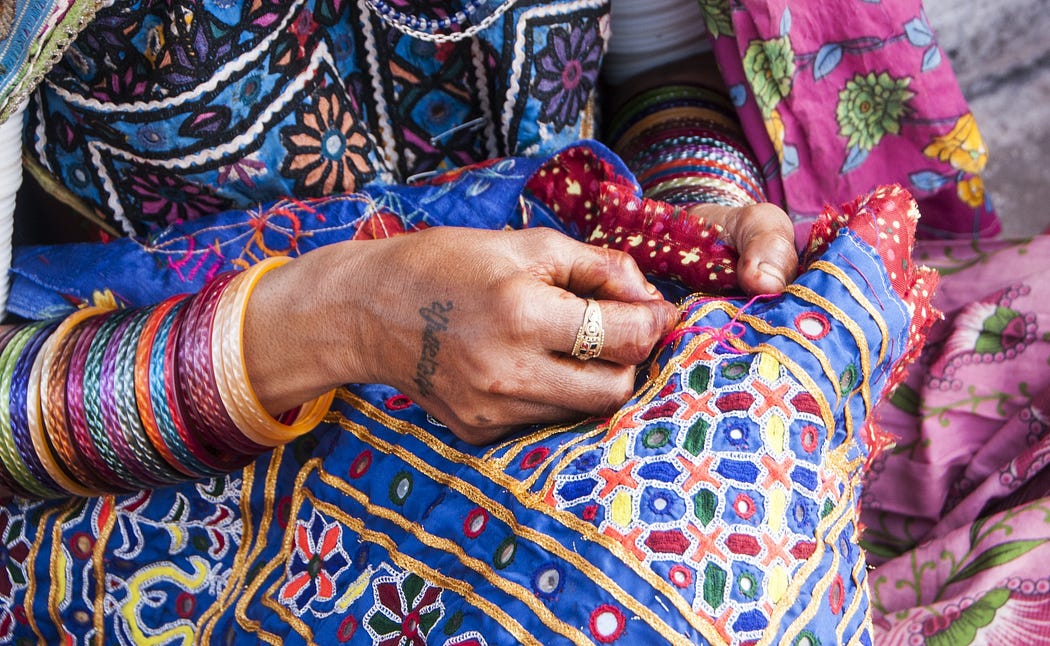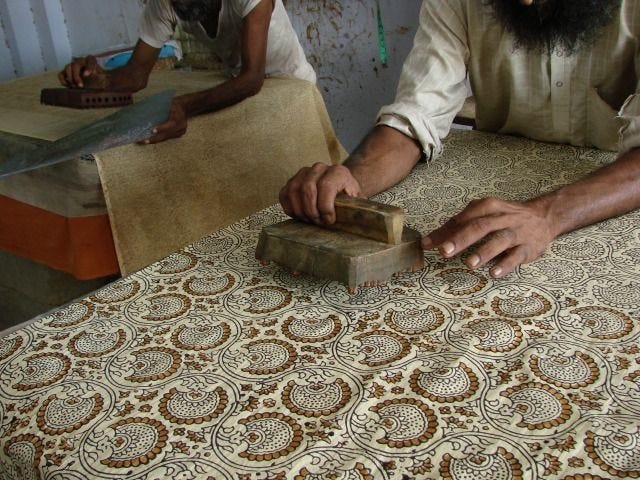Kutch Handicrafts — Rainbow in the White Desert.
Gujarat has the world’s largest Salt Desert in the Kutch region and it used to be only famous for salt manufacturing. But it has also a unique culture and craft created by diverse communities. Each community of Kutch is identified by distinct traditions, customs and crafts. Kutch Handicrafts are traditional crafts that include weaving, dyeing- printing and embroidery. Famous Handicrafts of this region are Kutch Embroidery, Ajrakh Printing, Bandhani, Leatherwork, Printed Terracotta, Wood and lac turnery, Bell Making, Silverwork, Namda-Felted rugs, etc. The embroidery is one of the main sources of income for the artisans of Kutch nowadays. Despite embroidery is the most traditional method, it is still very popular.
Kutch Embroidery
Kutch embroidery is purely made by hand. Embroidery is the method of ornamenting a piece of cloth with needlework, different colors of threads and with fanciful details. The uniqueness of this craft is the use of colors combined with different sizes of mirror works in between, sewn mostly in geometrical patterns using the different bright colors of wool and silk threads, beads. Artisans also use golden or silver metallic threads depend on the design and color of fabrics. Embroidery is usually crafted on cotton or silk fabrics. Motif and designs on fabrics are inspired by architectural, human motif as well as Persian and Mughal art.
Mirrors (Abhla in Gujarati) are a primary part of many embroidery styles in the Kutch region to make the fabrics shine. The mirrors are believed to represent water which is important in such a dry region.
Kutch embroidery work was practiced by Kanabi, Bhanushali, Satwara, Lohana and Mochi communities. Origin of Kutch Embroidery work was initiated back to ‘Mochis’ (community of shoemakers), who used to work on royal textile and decorative objects. Embroidery work has different styles, motifs, colors and patterns which vary from community to community.
Mochis — the cobblers community have been practicing their embroidery known as Mochi-Bharat or Aari Bharat. They have a unique design using unique colors and the floral style of embroidery. Motifs in the Aari Bharat represents their cultural background and surroundings. This embroidery was used in Home furnishings and hangings in the early 17th to the 19th century.
The communities such as Halaypotra, Pathan, Raysipotra, Darbar, Meghwar, Mutwa, and Sindhimemon were practicing Pakko, Neran, Kharek, Suf, Khudisebha and Mukko embroideries. Pakko embroidery depicts natural surroundings and geometric patterns, Suf is single stitched embroidery which is highly geometric so it requires skilled handwork involved in the design as it is done without drawing on the fabric. Kharek Embroidery is another masterpiece of Kutch artisans that requires an understanding of embroidery, stitch and motif as one cohesive indivisible unit as it fills the entire fabric while Neran Embroidery is the artwork of white dots which believed to be symbolic of the eye.
The style of the Jat community of Kutch is categorized into the Jat Dhaanetah and Jat Garaasiya. Designs of Jat Garaasiya are geometric and done on loose weave fabrics.
Ahir communities who are migrant from Mathura and settled in the western part of Gujarat Including Kutch. This community was practicing Ahir embroidery or Ahir Bharat. Ahir embroidery is inspired by nature which uses motifs like peacocks, parrots, scorpions, elephants, and flowers. It also depicts the flora and fauna, occupation and domestic activities of the people of the communities like Majyari (a lady churning curd),paniari(lady carrying water pot), etc.
Rabari Bharat (embroidery) which is done by the Rabari community uses lots of mirrors of varied shapes and sizes, nature-inspired abstract motifs, vibrant and colorful threads to represent their joyous culture. This embroidery is inspired by birds and animals like peacock, cat, elephant used with Vinchi(scorpion) and Temple motifs. We can see the rabari Bharat in various garments such as chili, shawls, and skirts. During the time of Navratri Festival, In Gujarat, this embroidery always stays in high demand by the customers.
The Mutwa Muslim communities of Kutch’s bani region specialized in Mutwa Pakki’s style of embroidery have intricate motifs aligned in a geometrical pattern. Culturally significant Chopad embroidery done by Mutwa which is indulgence in one of the oldest games of Chopad.
In the Kutch region, Young girls are taught this art by their mothers at an early age and it is passed down from generation to generation. It was said that a young girl who is skilled at embroidery can even find a good match in marriage!!
The traditional craft was originally seen on clothes or home furnishing products. Today, you can find there are lots of varieties of products such as bags, jackets, footwear, accessories and also jewelry of this art.
Ajrakh Printing
Ajrakh is one of the oldest crafts before the times of the Indus valley civilization. Ajrakh is a traditional dyeing and block printing process on cloth. Sindh region (now in Pakistan) is the birthplace of Ajrakh. Artisans belonged to Sindh and migrated to Kutch, Gujarat and Barmer, Rajasthan. The Khatri community of Kutch was involved in Ajrakh Printing from Dhamadka and Khavda villages before the earthquake of 2001. Then all these printers moved to the new village name Ajrakhpur. Mainly Khatris who have perfection in this craft is even now carrying the legacy of this traditional craft of their ancestors.
Natural elements such as flowers, leaves and star shapes are used in Ajrakh printings.
Ajrakh is an eco-sustainable style of printing done using natural dyes and gum pastes for printing. The traditional printing was predominantly done in blue (obtained from natural indigo dye), while secondary colors were red (obtained from alizarine), green (obtained from henna) and brown (from rubab). The motifs are generally outlined black to give highlights. Furthermore, the traditional Ajrakh artisans describe their designs and colors as a representation of the universe with Blue symbolizing the sky, red symbolizing the twilight, black symbolizes the darkness of the nights and the white symbolizes the hue and abundance of the stars. One can find Products from Ajrakh Printed Fabrics are like bedspreads, Scarves, Shoulder wear, Lungi, Safa (shoulder fabric), Kurtis, etc.
Even though Craft is unique and exclusive, people are finding its way into piracy by a cheap substitute and block printings. May craftsmen have left traditional method and started using modern the technique of block resist printing and use of multiple colors to face a tough competition to the original work. Except this, Artisans are facing issues that hinder their work are like the use of synthetic dyes and sophisticated machinery, Availability of Government loan, high cost of printing blocks, the crunch of water resources, Lack of young craft persons.
The Severe earthquake in 2001, has affected the people of Kutch. Post-earthquake many NGOs and urban civilians joined hands to help the communities and developed this region by discovering the rich resource of fashion and craft. The NGOs conducted training programs to train aspiring craftsperson in all relevant aspects and also gave monetary support. NGOs are also selling their products in the market. Many NGOs like Kutch Mahila Vikas Sangathan, Khamir, Kala Raksha, Bhujodi, etc are working on the Kutch handwork and creating a space of it into the global fashion market. Well — known designers of India are also working with skilled artisans for developing the unique and modern and indo-western style of the garments to make people aware and attracted to these crafts. Currently, the government has also initiated to promote Kutch tourism for creating industrial opportunities. These all initiatives by NGOs and government have led to Betterment in the socio-economic background of the communities. Today, Handicrafts of Kutch represents a unique style of culture and enthusiasm and is one of the most successful handicrafts in the world.




Comments
Post a Comment